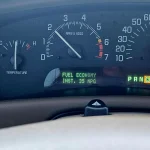What most folks don't take into account is that the "high performance" air filters tend to be made more for very high RPMs. They also allow larger particles to enter the engine, which are "just the right size" to grind the innards of the engine more aggressively than the smaller particles that make it past the paper filters.
At freeway speeds, the engine is turning around 18oo RPM. Since it's a 4-stroke, only half of the engine is consuming air on each revolution. A gallon (4 quarts) is 3.785 liters, and remarkably the "3800" engine is about the same size, so that means that it consumes only half a gallon per revolution. I don't know how many gallons are in 1 cubic foot, but a lot of volume measurements use CFM as the unit. For the sake of us regular Joes, a gallon is more familiar.
At 18oo RPM, only about half a gallon is consumed per revolution. 18oo RPM (times) ½ gallon = 9oo gallons per minute. Divide that by 60 and you get 15 gallons per second (GPS).
At higher RPMs, it consumes more air, so 36oo RPM = 30 GPS or 18oo GPM. 54oo RPM = 45 and 27oo. And if you're spinning the guts of out it at 72oo, those are 60 and 36oo.
The ECM tries to keep the air-fuel mixture as close to a stoichiometric ratio of 14.7 PPM (parts per million), which means that for every 1 million gallons of air consumed, it'll need approximately 14.7 gallons of fuel.
If the paper air filter is more than capable of passing enough air at any RPM, then a higher-flowing filter really isn't needed, even for boosted applications. And no one in their right mind would use sand paper on the cylinder walls, pistons, and rings. There is more power to be gained from other power adders than from that kind of air filter.
All of the above is my opinion. YMMV






